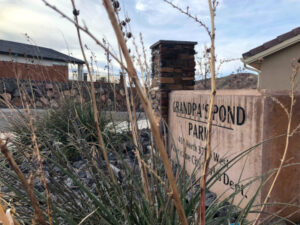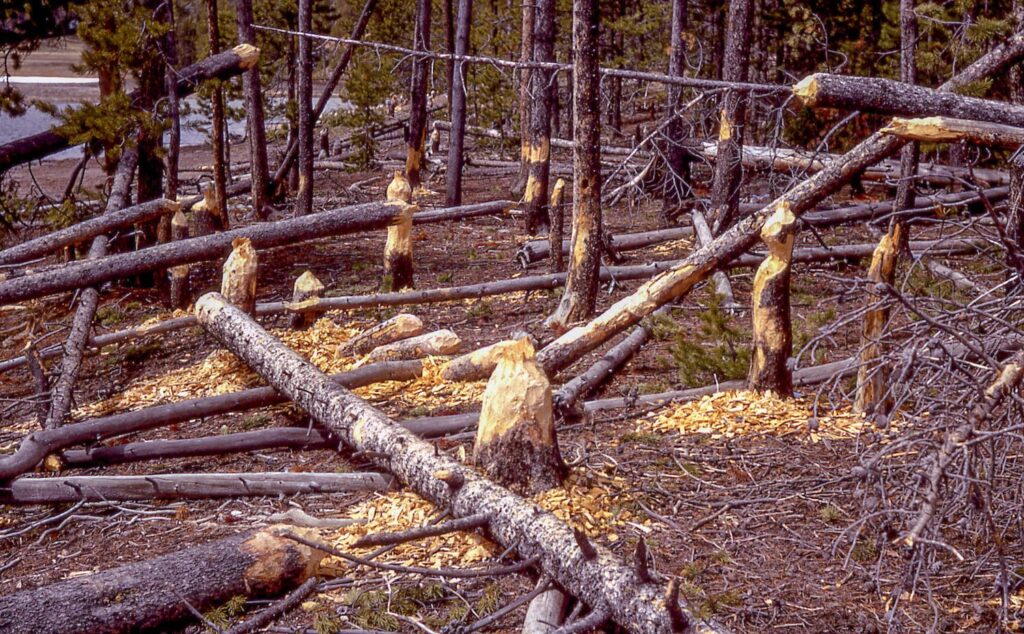Take a picture of this day and mark it on your calendar: Utah has just realized that even when beavers are relocated at incredible cost and effort NEW beavers can still move in! This must come as a huge shock for some.
Gnaw on wood, the beavers are back at Grandpa’s Pond in Hurricane
 ST. GEORGE — Last year, the Utah Division of Wildlife Resources relocated several beavers from the popular recreation area known as Grandpa’s Pond to remote places of Utah for wetlands restoration projects.
ST. GEORGE — Last year, the Utah Division of Wildlife Resources relocated several beavers from the popular recreation area known as Grandpa’s Pond to remote places of Utah for wetlands restoration projects.
St. George News made a recent trip to the public park, known for a level half-mile trail that loops a pond filled with birds of multiple species, located five miles southwest of Hurricane. At least two new trees are gone, the stumps showing large teeth marks and several more trees are wrapped in chicken wire fencing after being damaged. It seems the beavers didn’t want to leave.
Utah Division of Wildlife Resources Wildlife Program Manager Teresa Griffin confirmed state officials are working with Hurricane City Parks and Recreation staff on a solution for the current problem of beavers at Grandpa’s Pond. Beavers are often trapped and relocated by wildlife officials in Utah. When this happens, the animals receive a small antenna implant for tracking purposes, if they are large enough, Griffin said.
Did I know this? I didn’t know they got transmitter but I suppose it makes sense. I’ve never been wildly comfortable with anything about the beaver relocation program in Utah.
 “None of these beavers are ones we have trapped in the past,” she said said of the beavers at Grandpa’s Pond. “We moved most of the beavers up near Bryce Canyon to a remote area near the Sevier River, or another site where they were horse-packed into the Pine Valley wilderness to help repair the damaged watershed after a fire that occurred about four years ago.”
“None of these beavers are ones we have trapped in the past,” she said said of the beavers at Grandpa’s Pond. “We moved most of the beavers up near Bryce Canyon to a remote area near the Sevier River, or another site where they were horse-packed into the Pine Valley wilderness to help repair the damaged watershed after a fire that occurred about four years ago.”
Ohh you mean you got NEW ones even after all that work? It’s almost like all that trouble wasn’t worth it. I mean compared to wrapping trees and installing a flow device which would have allowed the old beavers to stay and keep away those NEW ones.
 “Grandpa’s Pond has some complicated issues since it frequently has people and dogs nearby,” she said. “So if we did set a live trap in the area, it would be somewhat dangerous because of the spring-loaded nature of the live traps.”
“Grandpa’s Pond has some complicated issues since it frequently has people and dogs nearby,” she said. “So if we did set a live trap in the area, it would be somewhat dangerous because of the spring-loaded nature of the live traps.”
Yeah we wouldn’t to catch a child or a dog. That might interfere with our whole funding stream.
Thomas Biebighauser, a wildlife biologist and wetland ecologist for Wetland Restoration and Training, completed more than 6,000 wetland restoration projects in many states, including Utah, during his career spanning four decades. From his home in Kentucky, he said that while beavers present problems for many landowners, they are also great for the surrounding habitat.
Many times he was watched as owners buy a secluded property with a stream, then spend both time and money lining the stream with expensive trees. The beavers love this, the property owners are usually “not so happy with the end result.”
“But if you love to fish, beaver ponds are great places for trout to reproduce,” Biebighauser said. “If you love to watch birds, you will see ducks, geese, herons, and many new species you have probably never seen. These ponds also reduce the chances of severe flooding and they restore groundwater by recharging the aquifer. I know many ranchers who have grown to love them once they realize the benefits.”
Thomas! I’m liking you! Let’s have less ‘musical beavers‘ and more letting people like you talk to the crowds. I think it’s a better investment.

Griffin said property owners can wrap a tree’s base in chicken wire to stop beavers from chomping on them, but if problems persist they can apply for a removal permit. In rare cases, a lethal permit may be issued.
“With the proximity of the Virgin River, it may be an on-going problem,” she said. “It seems wildlife really enjoy the nice parks we intend for humans.”
Both Griffin and Biebighauser said those hoping to see a beaver at Grandpa’s Pond would have the best opportunity at sundown, and walk quietly. Those who get spooked by a loud sound may have lost their chance.
“It will sound like a gunshot — it will be loud,” Biebighauser said. “That is the sound of a beaver’s tail slapping the water to warn others of danger.”
Yes. Exactly like a gun shot. Except nothing dies. Instead things spring to life and reproduce on an unbelievable scale. It’s funny how that happens.


















































